Whether you're an experienced angler or a novice fisherman, the Tuna Fishing Season in Massachusetts is a time of excitement, anticipation, and the thrill of the chase. You're drawn to the open sea, you're captivated by the tug of the line, and you're rewarded with the sight of a massive bluefin breaking the water's surface. There's something almost magical about it, isn't there?
But what if you knew more about the season, its impact on the local economy, and the role that this incredible fish plays in the local cuisine? And what if you understood better the environmental implications of tuna fishing? Sounds intriguing, doesn't it?
Let's explore this further.
Key Takeaways
- Tuna fishing season in Massachusetts typically spans from June to November, with peak months being July through October.
- Understanding and adhering to the regulations governing tuna fishing in Massachusetts is crucial for conservation and sustainability.
- The best times and locations for tuna fishing in Massachusetts are from July to October, with hotspots including Stellwagen Bank, Jeffries Ledge, and Cape Cod Bay.
- Tuna season in Massachusetts has significant economic benefits for the local economy, including increased tourism, employment opportunities, and support for local businesses.
Understanding Massachusetts Tuna Season
Diving into the heart of Massachusetts' tuna fishing season, you'll find it typically spans from June to November, with the peak months being July through October. Understanding Massachusetts tuna season is key to a successful catch. Federal regulations allow you to keep three Bluefin tuna of varying sizes, but remember, any fish over 73 inches becomes the property of the boat and must be sold to authorized dealers.
You might consider chartering a boat from companies like Karen Lynn Charters in Gloucester, where they offer a full day Bluefin Tuna Charter for $1650, or a Marathon Day for $1950 for up to six people. Gloucester, being centrally located to the most productive Bluefin Tuna fishing grounds in New England, increases your chances of a successful catch.
Various techniques can be employed such as bait fishing, kite fishing, jigging on the anchor, and trolling, but remember, the best times for Gloucester tuna fishing are still July to October. So, gear up and get ready to dive into the thrilling experience of the tuna fishing season in Massachusetts.
Best Times for Tuna Fishing
Building on your understanding of the Massachusetts tuna season, it's crucial to pinpoint the ideal times for tuna fishing, with the period from July to October offering the most promising opportunities. Although the Tuna fishing season in Massachusetts officially opens on June 1st, the warmer summer months through early fall tend to be more productive.
A closer look at the best times for tuna fishing reveals that:
- The warmer weather patterns attract tuna closer to the surface, making them easier to spot and catch.
- The abundance of baitfish during these months also draws tuna to feeding grounds near the shore.
- Specific hotspots in Massachusetts waters yield better results. These include:
- Stellwagen Bank: Known for its high concentration of bluefin tuna.
- Jeffries Ledge: A popular spot due to its underwater topography.
- Pigeon Hill: Its deep waters are a favorite among experienced anglers.
Remember that tuna fishing isn't just about the right time and place. It's also about being part of a community that shares in the thrill and respect for these magnificent creatures. Enjoy the season and tight lines!
Regulations of Tuna Fishing
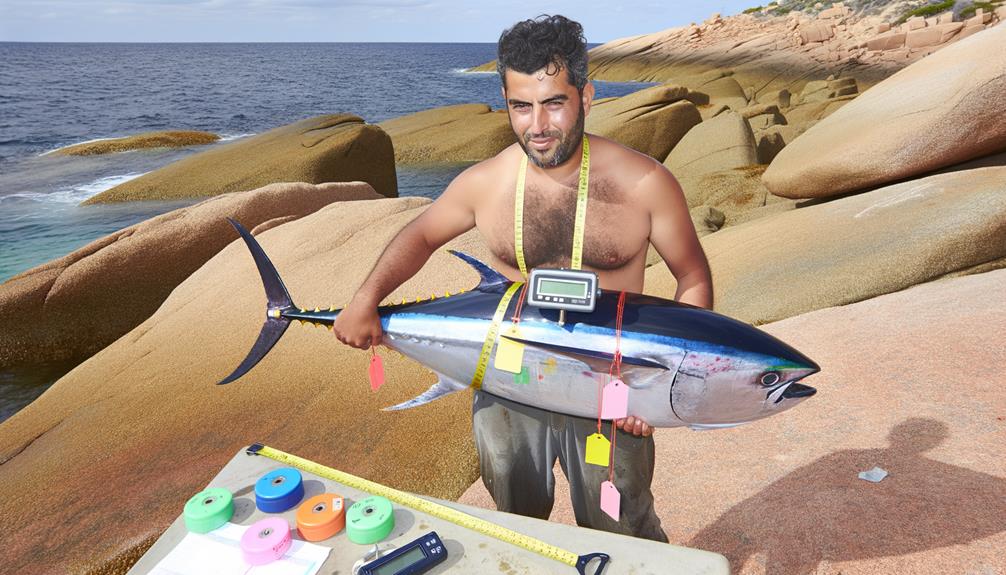
As you venture into the world of tuna fishing in Massachusetts, it's crucial that you're well-versed in the regulations that govern this activity. Understanding the licensing rules, size and catch limits, as well as the enforcement and penalties for non-compliance ensures that you fish responsibly and sustainably.
This knowledge not only protects you from legal repercussions but also contributes to the survival of the tuna species in the long run.
Tuna Fishing Licensing Rules
Often, you'll find that tuna fishing regulations in Massachusetts are quite specific, including restricted-fishing days and zero bluefin tuna retention limits on certain days from July 1 to November 30, 2023. This is part of the broader tuna fishing licensing rules designed to manage the tuna fishing season in Massachusetts.
- *Restricted-Fishing Days (RFDs)*: These limit commercial fishing and possession of bluefin tuna.
- Commercial fishing: Prohibited on RFDs for Atlantic Tunas General category permitted vessels.
- HMS Charter/Headboat permitted vessels: Can do recreational fishing under applicable rules but are restricted from commercial fishing on RFDs.
- *Regulation Flexibility*: NOAA Fisheries can waive certain RFDs and increase retention limits.
- Compliance guide, 2023 Restricted Fishing Days Calendar, and detailed Federal Register information assist in adhering to these regulations.
Size and Catch Limits
When it comes to the size and catch limits for tuna fishing in Massachusetts, you'll find that federal regulations dictate the retention of three Bluefin tuna of varying sizes per trip. Bluefin Tuna Fishing, under these rules, becomes a matter of understanding the size class of your catch.
| Size Class | Quantity | Regulations |
|---|---|---|
| Small | 1 | Must be 27-47 inches |
| Medium | 1 | Must be 47-73 inches |
| Large | 1 | Over 73 inches, belongs to boat |
Enforcement and Penalties
Navigating the enforcement and penalties of tuna fishing regulations is crucial, as any violation could lead to severe repercussions including hefty fines and even the possibility of fishing permit suspension or revocation. As a valued member of the Tuna Fishing Charters community, it's your responsibility to abide by the rules.
Be aware of Restricted Fishing Days (RFDs) as violations can lead to:
- Hefty fines
- Suspension or revocation of fishing permits
NOAA Fisheries may waive certain RFDs, but only with official approval. Commercial prohibitions apply on RFDs, non-compliance can result in severe penalties.
Above all, maintaining regulatory compliance safeguards our shared resource, ensuring future tuna fishing seasons.
With careful attention to enforcement and penalties, you're contributing to the sustainability of our beloved sport.
The Economic Impact of Tuna Season
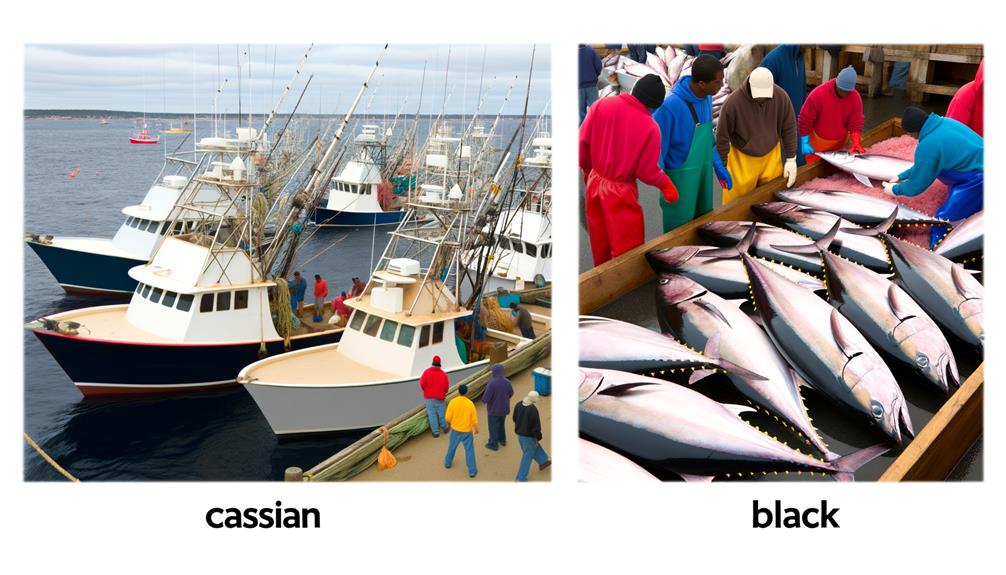
Diving into the economic impact of tuna season, you'll find significant financial benefits ripple throughout Massachusetts, particularly bolstering charter boat operators, fishing gear suppliers, and local businesses catering to anglers. Indeed, the tuna fishing season in Massachusetts is a critical driver of economic activity, extending its influence beyond the fishing community and into the broader regional economy.
Take a closer look, and you'll see how it boosts tourism, filling up hotels and restaurants in coastal areas like Gloucester. Local fish markets and seafood restaurants revel in the increased availability of fresh bluefin tuna, drawing in customers and heightening the local culinary scene.
The economic impact of tuna season doesn't stop there. It spawns employment opportunities, from charter boat crews to dockworkers, underpinning the region's economic vitality. Moreover, it highlights the importance of sustainable management practices, ensuring the long-term viability of the fishery and its associated economic benefits.
The Role of Tuna in Local Cuisine
You'll find that tuna holds a significant place in Massachusetts' local cuisine, both in traditional recipes and innovative culinary creations.
Its versatility makes it a favorite, served as succulent steaks, delicate sashimi, or integrated into salads and sandwiches.
This demand for fresh, locally-sourced tuna hasn't only elevated the culinary scene but also impacted the fishing industry significantly.
Tuna-Based Traditional Recipes
In the rich tapestry of Massachusetts' local cuisine, tuna-based traditional recipes hold a prominent place, expertly showcasing the fish's versatility and robust flavor profiles.
You'll find tuna, especially the best Bluefin Tuna, entwined with the region's cultural and culinary heritage. Traditional recipes have been passed down through generations, reflecting a deep connection to the sea:
- Tuna steaks, seared to perfection, offer a hearty main course.
- Lighter dishes, like tuna salad, highlight the freshness of the catch.
- Innovative creations, such as tuna poke bowls and tuna tataki, demonstrate the ongoing evolution of local cuisine.
These dishes emphasize the simplicity and purity of the fish, allowing its natural flavors to shine.
In Massachusetts, tuna isn't just food—it's a testament to a rich, shared heritage.
Innovative Tuna Dishes
As you explore the culinary landscape of Massachusetts, you'll discover that chefs are pushing boundaries by incorporating tuna into innovative dishes, redefining traditional New England cuisine with a unique, flavorful twist.
Bluefin, the star of the show, is creatively used in everything from seared steaks to tartare, demonstrating its versatile nature. This amazing tuna's role goes beyond traditional recipes, forging a new culinary path that celebrates its rich flavors.
You'll find the freshness and quality of the locally caught tuna highlighted in specialty dishes throughout restaurants, showcasing the fish's significance in the local cuisine. These inventive and unique dishes are a testament to the experimental spirit of Massachusetts' chefs, and their commitment to honoring the region's prized catch.
Tuna Fishing Techniques and Strategies
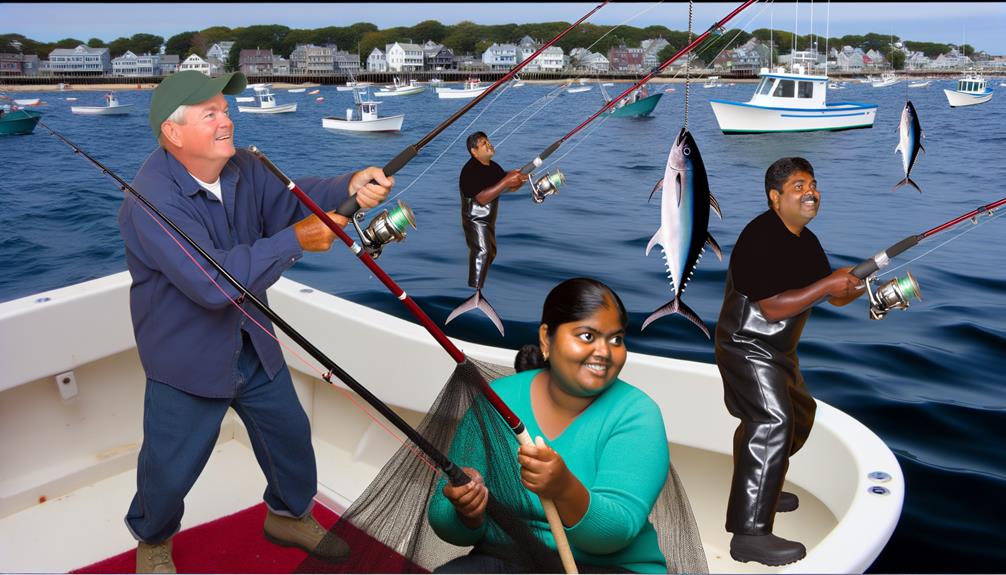
To successfully catch bluefin tuna during the fishing season in Massachusetts, which typically runs from June to November, you must employ effective techniques such as trolling and drifting live bait, and use technologies like sonar to locate feeding pods of tuna. These tuna fishing techniques and strategies are crucial to a rewarding and successful fishing expedition.
To enhance your fishing experience, consider:
- Trolling:
- Use a rod and reel combination with high line capacity and drag pressure.
- Employ a variety of trolling speeds to attract the bluefin's attention.
- Drifting Live Bait:
- Use a balloon or kite to keep the bait at the surface.
- Change baits frequently to ensure they're lively.
- Sonar Technology:
- Use sonar to locate schools of tuna below the surface.
- Learn to interpret sonar readings to pinpoint tuna's location.
Environmental Impact of Tuna Fishing
While you're employing those effective fishing strategies, it's essential to understand the environmental impact of tuna fishing and the regulations designed to safeguard the bluefin tuna population. The tuna fishery is governed by specific regulations, including restricted fishing days and zero retention limits on certain days to lessen fishing pressure.
As a stakeholder in the tuna fishery, you might be affected by these regulations if you hold an Atlantic Tunas General category or HMS Charter/Headboat permit, are a dealer in the Atlantic bluefin tuna market or participate in bluefin tuna tournaments. To help you navigate these rules, resources such as a compliance guide and the 2023 Restricted Fishing Days Calendar are available.
Bluefin tuna's high demand and value in the sushi market influence the environmental impact of tuna fishing. This necessitates proper handling practices to maintain the quality and value of the fish. Therefore, it's not just about fishing; it's about fishing responsibly and sustainably. This way, you contribute to the preservation of the bluefin population, ensuring the future of the tuna fishery you belong to.
Key Fishing Locations in Massachusetts
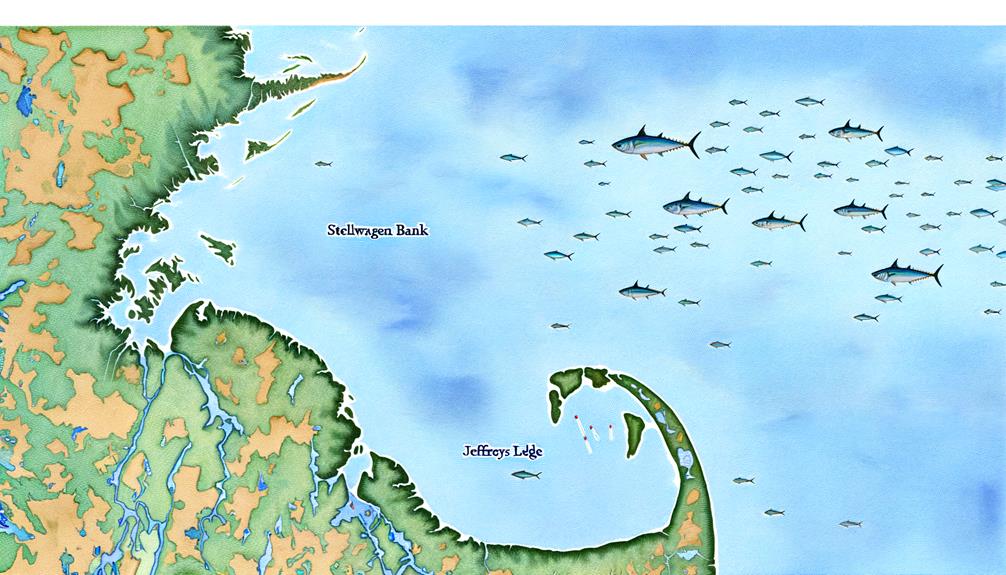
Having established the importance of responsible fishing practices, let's now explore the key fishing locations in Massachusetts for bluefin tuna. Gloucester, Cape Cod, and Ipswich are known hotspots, offering close proximity to the fertile fishing grounds of Jeffries Ledge, Tillies Bank, and Stellwagen Bank.
- Gloucester
- Stellwagon Bank: A premier location during the tuna fishing season in Massachusetts, known for sizeable catches.
- Jeffries Ledge: Another favorite, particularly productive from July through October.
- Cape Cod
- Cape Cod Bay: A renowned hotspot, typically yielding a high quantity of fish.
- Old Scantum: Noted for its accessibility and consistent catches.
- Ipswich
- The Flags: A less crowded location, offering a serene fishing experience.
- Pigeon Hill: Known for its diversity of species, including bluefin tuna.
Each location has its unique charm and challenges, but they all contribute to make Massachusetts a prime destination for bluefin tuna fishing.
Remember, the Massachusetts bluefin tuna season generally runs from June to November, with peak months being July through October. Additionally, fishing here is regulated by NOAA, ensuring sustainable practices and appropriate bag limits.
As you plan your trip, consider these key fishing locations in Massachusetts.
Stories From Experienced Tuna Fishermen
Diving into the tales of experienced tuna fishermen, you'll uncover invaluable insights, strategies, and techniques, all honed through years of navigating the bluefin tuna fishing season in Massachusetts. Their stories reveal not just the art of fishing, but the science behind understanding the behavior and migration patterns of this prized fish.
As you absorb these stories from experienced tuna fishermen, you'll gain knowledge on the best times of the year for bluefin tuna fishing and the most productive fishing spots. You'll become privy to their well-guarded secrets of maintaining the fish's quality to maximize its value. They'll share their wisdom on when to reel in and when to let go, helping you master the dance of patience and action crucial in this sport.
You'll also discover how popular culture, specifically shows like 'Wicked Tuna', has influenced the tuna season and the industry as a whole. This shared wisdom, embedded in their narratives, fosters a sense of belonging, making you part of this close-knit community. By learning from their experiences, you're not just fishing; you're becoming part of a grander tradition.
Preparing for Your Tuna Fishing Trip
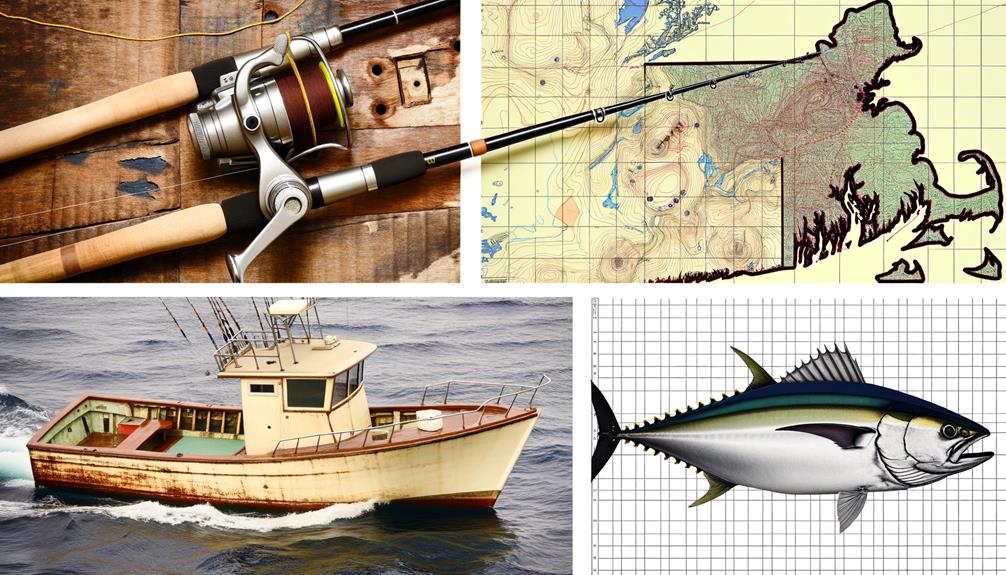
Before you hit the waters for your tuna fishing adventure in Massachusetts, it's crucial to equip yourself with the necessary tackle.
Understanding the behavior of tuna can significantly enhance your chances of landing a big one.
Essential Tuna Fishing Gear
When preparing for your tuna fishing trip, it's crucial to equip yourself with the right gear. This includes rods and reels specifically designed to handle the strength and speed of massive Atlantic Bluefin Tuna. Essential tuna fishing gear isn't limited to just that.
- High-quality lures and baits are also necessary. This can include squid bars, as well as live or dead bait.
- You'll also need heavy-duty fishing line and leaders to bear the weight and pull of the fish.
- Landing equipment is crucial for a safe catch. This can include a gaff or harpoon. Additionally, efficient coolers or fish bags are necessary to keep your catch fresh.
These items aren't mere accessories, but a necessity. Your success and enjoyment during the Massachusetts tuna fishing season can hinge on having the right equipment.
Understanding Tuna Behavior
To improve your chances of a successful catch during the Massachusetts tuna fishing season, it's essential to grasp the behavior and characteristics of Bluefin tuna. You can accomplish this by becoming part of a Bluefin Tuna Charter, gaining firsthand experience and understanding tuna behavior.
Here's a concise table that will assist you:
| Behavior | Technique | Season |
|---|---|---|
| Migration | Locate feeding grounds | June-November |
| Speed | Drifting live bait | July-October |
| Size | Trolling | Peak in July-October |
| Regulation | Proper handling | Throughout season |
Frequently Asked Questions
Where Can I Fish for Tuna in Massachusetts?
You can fish for tuna in Massachusetts at several spots. Try Gloucester, Cape Cod, and Ipswich. They're rich in Bluefin Tuna, a species known to favor the local bait there. Happy fishing!
How Long Is the Bluefin Tuna Season in Gloucester Massachusetts?
You're asking about the bluefin tuna season in Gloucester, Massachusetts. It's usually from June to November, impacted by tuna conservation efforts and bluefin population dynamics. It's a tight-knit community experience, respecting both tradition and sustainability.
What Month Is Best for Tuna Fishing?
You'll find the best month for tuna fishing is typically July through October. Your choice of tuna bait and fishing techniques can greatly influence your success during these peak months.
Do You Need a Permit to Catch Tuna in Massachusetts?
Yes, you need a permit to catch tuna in Massachusetts. It's crucial to follow permit regulations and respect tuna quotas to ensure the fish's sustainability. It's not just about fishing, it's stewardship.
Conclusion
As the curtain falls on the Massachusetts tuna season, it's like a grand theater production reaching its finale. You've witnessed the thrill of the chase, the drama of regulations, the economic ballet, and the culinary encore.
As you review the environmental costs and recall the tales spun by seasoned fishermen, it's evident that your fishing trip was more than just a voyage; it was an immersive journey into the heart of the bluefin's world.
